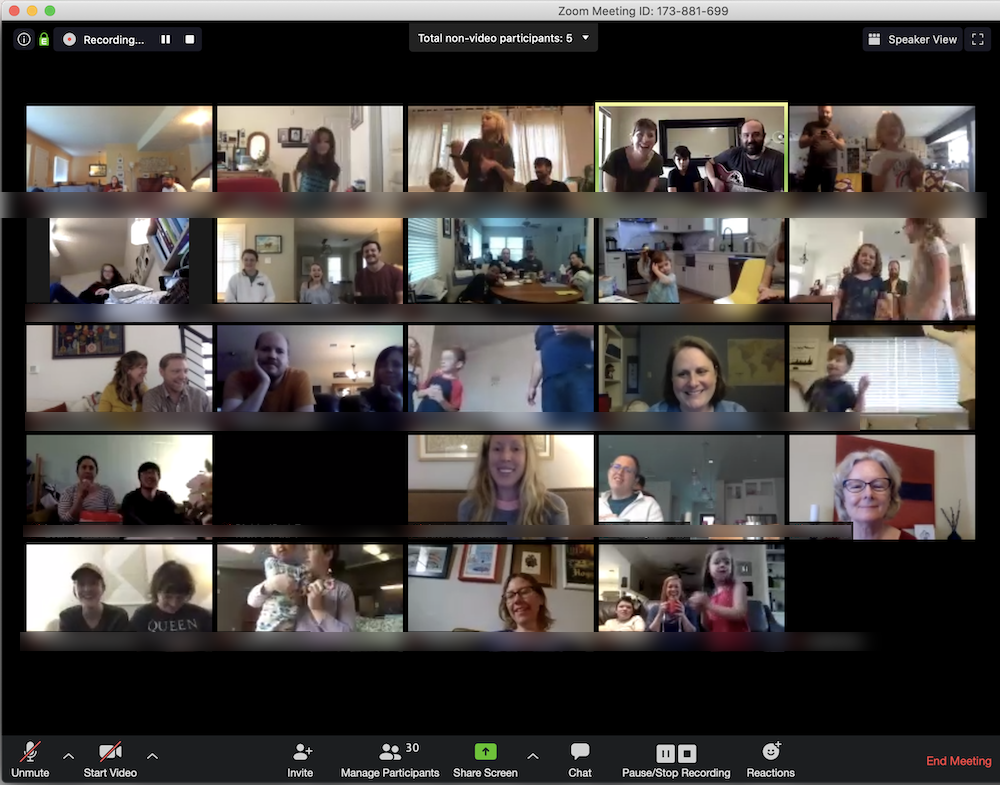Several decades ago, communications theorist Marshall McLuhan coined the phrase, “the medium is the message.” In other words, the form, or medium, that is used to communicate a message will shape how that message is received and understood.
As more cities and counties issue orders to shelter in place, churches are forced to rethink the medium used to deliver their message.
Tweet this.
No longer able to gather in person, church leaders are asking how to create meaningful online gatherings.
An Experiment in Online Liturgy
Last Sunday for the first time in Austin Mustard Seed’s short life, we gathered for liturgy online. Overwhelmingly the feedback has been that those who came felt God’s presence among us. Many wept throughout the gathering. There was a sense of gratitude for the ability to see and hear each other as we worshipped and prayed.
For the past seven years at Austin Mustard Seed, we’ve focused on designing a Sunday liturgy with elements that invite interaction and participation. Even before the pandemic, this was important because it allowed as many voices as possible to be heard rather than relying on just a few leaders. Volunteers read prayers and give the announcements. The Prayers of the People is open-mic, giving voice to anyone who wishes to share a celebration or prayer request.
Participation in this kind of liturgy is a form of discipleship. It teaches what 1 Corinthians 14:26 says, “When you come together, each of you has a hymn, or a word of instruction, a revelation, a tongue or an interpretation.” The word liturgy means “the work of the people.” Each Sunday our liturgy comes together through our common work.
Maintaining Strong Levels of Engagement
When faced with possibly taking our liturgy online, one of the first considerations we had was how to maintain the same level of engagement. Technology can create disconnection and shorten attention spans. And we didn’t want the online version of our liturgy to be created for consumption. We hoped for participation — for connection. What surprised us, and what we are grateful for, is that we surpassed our usual level of participation.
Here’s how we did it:
First we chose Zoom as our platform rather than a livestream. Zoom is interactive whether by inviting participants to speak on mic or type into the chatbox. The paid version of Zoom allows for unlimited meeting time. As usual, a handful of people were asked to participate as readers and to lead songs. This worked well.
Next we determined the flow of our liturgy. We wanted to keep things as familiar as possible and maintain mostly the same flow. We did that with two notable changes. There was more participation from our kids and more interaction between adult participants.
Sample Online Liturgy Flow
Our flow looked like this:
- Welcome & “how to participate in online liturgy” (this is new to us all!)
- Song
- Call to Worship (read by a participant)
- Kids Song (kids are invited to dance on screen)
- Song
- Confession (responsive reading)
- Kid’s Bible story (dismiss kids at parent’s discretion)
- Sermon (12-15 minutes, including slides)
- Silence
- Participant response (invite responses to the day’s text whether song, prayer, thought, encouragement, etc.)
- Prayers of the People (some participants were unmuted to share prayer requests, others in the chatbox)
- Eucharist (more about how we did this below)
- Offering (Link to our online giving page)
- Song
- Announcements
- Benediction (read by a participant)
Despite the digital medium, levels of connection, engagement, and participation were high. We achieved that by deliberately making space for people to share, and by being willing to have moments of awkwardness and imperfection.
Despite the digital medium, levels of connection, engagement, and participation were high. We achieved that by deliberately making space for people to share, and by being willing to have moments of awkwardness and imperfection.
Tweet this.
Highly relational communities, like families, have both!
Since we were not able to physically be together, we held space for emotional connection. After the sermon, participants were asked to reflect in silence for two minutes. Following the silence we opened it up for anyone who wished to share. Songs and words of encouragement spontaneously flowed, including from our teenagers! Later, during the Prayers of the People, many shared the burdens they’re carrying.
All together, the sharing and prayer time was longer than the sermon. This was a community-led time of worship, prayer, and mutual edification facilitated by those of us who pastor, but in no way produced or scripted by anyone other than the Holy Spirit. I came away deeply encouraged and moved by what was shared.
I hope that as we continue practicing this way of being formed online together, we are creating new habits to bring back into the physical spaces where we will gather again when the pandemic has passed.
What Logistics Need to be Considered?
Having a participatory liturgy online means many logistics to consider.
Technical Aspects
We made sure everyone who would be reading on screen had some basic information: a) good front-facing light b) camera at eye level c) mic check before liturgy.
Every Sunday we have someone act as liturgy producer, making sure everyone knows their role and that liturgy flows well. Online liturgy is no different. The producer acts as the host of the gathering, muting and unmuting the mic of whoever is talking. Our liturgy host also facilitated the post-sermon sharing time and the prayers of the people.
Participants were asked to type into the chatbox when they had something to share during the reflection time or Prayers of the People. The host called on them and unmuted their mics in order, making sure everyone was able to share. This kept multiple people from being unmuted at one time.
Eucharist
We shared Eucharist together while apart. This is done weekly on a normal Sunday and we say it is the “center of our liturgy.” Usually everyone comes forward to the table to receive the bread and wine. For our online liturgy, we practiced by taking the bread all at once together followed by the wine all at once together, each individual or family from their home. Despite us not being the gathered body in the physical sense, the Eucharist felt even more central to our liturgy than usual.
After Eucharist we reminded everyone of the importance of giving and collected an offering. Our church has encouraged online giving for some time, and we are grateful to see our giving remain stable so far. However, we anticipate that will change as people begin to lose jobs and income. It will be even more important for us to steward our finances well in order to care for those in need.
Children
Kids are a huge part of our community and we wanted them to be included. We planned a song just for the kids and invited them to participate and dance for all of us to see! Later, before the sermon, our Children’s Pastor read the children a Bible story. After that we left it to the discretion of caregivers whether to dismiss the children. As with our usual practice, kids were invited back in for Eucharist.
Conclusions
Many of us know the history of church in homes and have even been part of a house church before. My family was in a house church network for about 10 years before returning to “regular” church at Austin Mustard Seed. During that time my imagination for various ways the church can reach people grew. Church while sheltering in place is not the same as house church because we’re unable to gather, even with just a few in our homes around tables. However, having an imagination for unconventional ways of doing church will serve those of us well who are leaders in the weeks and months ahead.
Having an imagination for unconventional ways of doing church will serve those of us well who are leaders in the weeks and months ahead.
Tweet this.
Ready to try it out?
Here’s a Cheatsheet for an Online Participatory Liturgy:
- Review your order of worship and look for ways to include multiple people.
- Ask someone to act as “producer,” running slides, muting and unmuting people.
- Use Zoom’s “Meeting” Function
- Involve kids
- Involve multiple people as speakers
- Leave time for silence and contemplation
- Leave time to share prayer requests
- Remind people to give online
- Last but not least: Cut yourself some slack, this is new to most people!
Happy Zooming!


